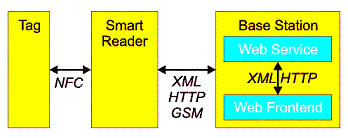Forschungsbericht 2009
FacilSurv - Facility Surveillance
Traditionally facility surveillance is performed by watchmen that inspect the facility. On their tours they have to visit certain points with specialized devices. Audit trails are produced to verify a watchmans reliability. To measure certain environmental values modern facilities are often equipped with specialized sensors and watchmen periodically perform metering. Despite the usage of modern communication means such as mobile phones, a holistic procedure making use of state of the art technology is still missing. This project develops an integrated approach to facility surveillance providing several added values. The technology uses smart phones equipped with NFC and location capabilities. In combination with extended NFC compatible RFID tags including sensors and processing capabilities a new level of automated surveillance reducing the overall costs is achieved. The scenario chosen for this project are security guards. On their tours they have to carry a device that they plug into other devices fixed attached to buildings or other places, visiting a scheduled number of checkpoints, documenting that they were there at a specific time. The only purpose for this is controlling the work of the security guard afterwards. Although some of these devices yet do use RFID technology, it still leaves much of its potential unused. Common modern mobile phones, that security guards carry anyhow as communication device, their storage, communication and processing capabilities, equipped with NFC, can be used to extend the bare after work control application to a online control, communication, sensor measurement and location routing application. Those devices are much more than just a time-item-tupelo recording device. Security guards can collect and check data, communicate with headquarter or colleagues and can be efficiently directed to a desired location. Beside this also the checkpoints extend their functionality far beyond just revealing their ID. They also can cache data from security guards visiting before, e. g. allowing reconstructing incident of disappearing staff afterwards, or measure environmental values from sensors. Checkpoints do not need to be simple RFID tags, they can also be full featured devices, connected to power and communication infrastructure, like access control systems, that can also reveal the persons entering the building before to the security guard. There is no need that these checkpoints have to be dedicated only to this special application.
Stichwörter
|








